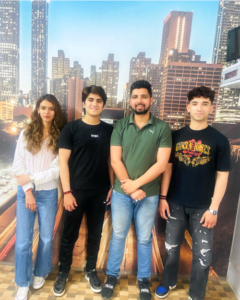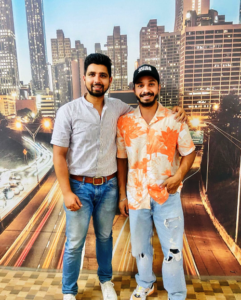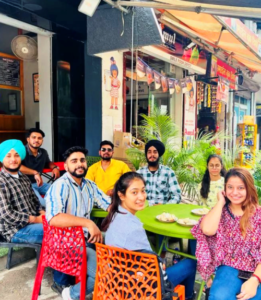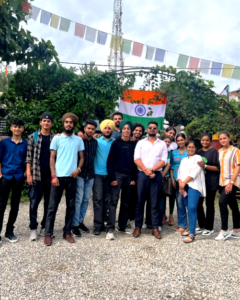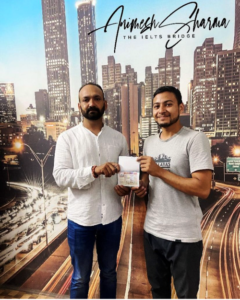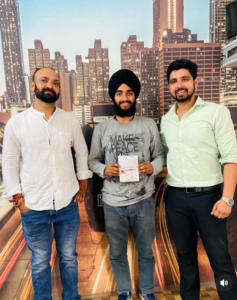Section 1: Helping pupils to choose optional subjects when they are aged 14-15: what some pupils say
Questions 1-6: Identifying information
[This question asks you to find information from the passage and write the number of the paragraph (A, B, C or D … .. ) in the answer sheet. Now, if the question is given in the very first part of the question set, I’d request you not to answer them. It’s mainly because this question will not follow any sequence, and so it will surely kill your time. Rather, you should answer all the other questions first. And just like List of Headings, only read the first two lines or last two lines of the expected paragraph initially. If you find the answers, you need not read the middle part. If you don’t find answers yet, you can skim the middle part of the paragraph. Keywords will be a useful matter here.]
Question 1: This pupil is interested in the subject despite the way it is taught.
Keywords for this question: interested in, the subject, despite, way it is taught,
In paragraph D, Violeta says in lines 3-5, “ . . . the teacher is very knowledgeable, though I think we spend too much time listening to her: I’d like to meet more people working in the sector, and learn from their experience.”
Here, though I think we spend too much time listening to her = despite the way it is taught,
like to meet more people working in the sector, and learn from their experience = This pupil is interested in the subject,
So, the answer is: D
Question 2: This pupil is hoping to have a career that makes use of the subject.
Keywords for this question: hoping, a career, refund, makes use of the subject,
In paragraph B, Lucy says in the final lines, “ . . . My plan is to study history at university, and maybe go into the diplomatic service, so l can apply a knowledge of history.”
Here, My plan is to study history at university, and maybe go into the diplomatic service = hoping to have a career that makes use of the subject,
So, the answer is: B
Question 3: This pupil finds the subject harder than they expected.
Keywords for this question: finds the subject harder, than, expected,
In paragraph C, Mark says in lines 3-4, “ . . . . I didn’t think I’d have any problem with it, but I was quite wrong! . .. .”
Here, I didn’t think I’d have any problem with it, but I was quite wrong = harder than they expected,
So, the answer is: C
Question 4: This pupil finds the lessons very entertaining.
Keywords for this question: finds the lessons, very entertaining,
In paragraph E, Walid says in lines 2-3, “ . . . I was afraid the lessons might be a bit dull. I needn’t have worried, though – our teacher gets us to do lots of fun things, so there’s no risk of getting bored. . .. . .”
Here, our teacher gets us to do lots of fun things, so there’s no risk of getting bored = finds the lessons very entertaining,
So, the answer is: E
Question 5: This pupil appreciates the benefit of doing challenging work.
Keywords for this question: appreciates, benefit, doing challenging work,
In paragraph A, Krishnan says in lines 2-4, “ . . . Mr Peckham really pushes us, and offers us extra assignments, to help us improve. That’s good for me, because otherwise I’d be quite lazy.”
Here, offers us extra assignments, to help us improve. That’s good for me, because otherwise I’d be quite lazy = appreciates the benefit of doing challenging work,
So, the answer is: A
Question 6: This pupil has realised the connection between two things.
Keywords for this question: realised, connection between two things,
In paragraph B, Lucy says in lines 1-2, “ . . . History is my favourite subject, and it’s fascinating to see how what we learn about the past is relevant to what’s going on in the world now. .. . .. .”
Here, it’s fascinating to see how what we learn about the past is relevant to what’s going on in the world now = has realised the connection between two things,
So, the answer is: B
It’s almost time for the next Ripton Festival
Questions 8-14: TRUE, FALSE, NOT GIVEN
[In this type of question, candidates are asked to find out whether:
The statement in the question agrees with the information in the passage – TRUEThe statement in the question contradicts the information in the passage – FALSEIf there is no information on this – NOT GIVEN
For this type of question, you can divide each statement into three independent pieces and make your way through with the answer. This question type generally follows a sequence. So, scanning skill is effective here.]
Question 7: The festival is held every year.
Keywords for this question: held, every year,
The answer is in the very first lines where the writer says, “As usual, the festival will be held in the last weekend of June, this year on Saturday to Monday, 27-29 June. . . .. . .. .”
Here, As usual = like every year,
This means the festival is a yearly event.
So, the answer is: TRUE
Question 8: This year’s festival focuses on the town’s history.
Keywords for this question: This year’s festival, focuses, town’s history,
In lines 2-3 of the passage, the writer says, “ . . .. . .. . The theme is Ripton through the ages. Scenes will be acted out showing how the town has developed since it was first established. . .. .”
Here, The theme = This year’s festival focuses, Ripton through the ages = the town’s history,
So, the answer is: TRUE
Question 9: Goods displayed in the craft fair are unlike ones found in shops.
Keywords for this question: goods, displayed in the craft fair, unlike ones, found in shops,
The second paragraph talks about the craft fair. However, there is no comparison of goods with other shops.
So, the answer is: NOT GIVEN
Question 10: The barbecue will be cancelled if it rains.
Keywords for this question: barbecue, will be cancelled, if it rains,
We find a discussion about ‘barbecue’ in paragraph no. 3, and the writer says in line no. 2, “ .. . he barbecue will be held in Palmer’s Field, or in the town hall if there’s rain. . . .. .. .”
Here, in the town hall if there’s rain = The barbecue will NOT be cancelled if it rains, it will take place in the town hall instead.
So, the answer is: FALSE
Question 11: Adults can attend the barbecue at any time without charge.
Keywords for this question: Adults can attend, barbecue, any time without charge,
In paragraph no. 3, lines 3-4 say, “ . . . Entry for under 16s is free all day; adults can come for free until 6 pm and pay £5 after that.. . . .”
Here, adults can come for free until 6 pm and pay £5 after that = Adults can attend the barbecue without charge until 6 pm, but after that they have to pay.
So, the answer is: FALSE
Question 12: Amateur musicians will perform during the whole of the barbecue.
Keywords for this question: Amateur musicians, will perform, during, whole of the barbecue,
The final lines of paragraph no. 3 say, “. .. . with local amateur bands in the afternoon and professional musicians in the evening.”
Here, local amateur bands in the afternoon = Amateur musicians will perform in the afternoon only,
So the answer is: FALSE
Question 13: Seating is available for watching the boat races.
Keywords for this question: seating, available, for watching the boat races,
In the fourth paragraph, lines 2-3 say, “ . .. . The spectator area by the bridge has plenty of room to stand and cheer the boats home, in addition to a number of benches. .. . .. . .”
Here, in addition to a number of benches = There will be some seats for watching the boat race,
So the answer is: TRUE
Question 14: People attending the festival will be asked to donate some money.
Keywords for this question: People attending the festival, will be asked, donate some money,
In the final line of the passage, it says, “All money raised by the festival will go to support the sports clubs in Ripton.”
However, there is NO MENTION of any donation by people.
So the answer is: NOT GIVEN
Section 2: Reducing injuries on the farm
Questions 15-20: Completing the table
[In this type of question candidates need to fill in the gaps in a table. For this table, candidates need to write ONE WORD ONLY to fill in the blanks. Scanning skill is essential for this type of question.]
Question 15:
Risk factor: Heavy loads
Examples of farm activities: lifting sacks of _________.
Keywords for this question: heavy loads, lifting sacks,
Take a look at lines 1-4 in paragraph no. 2 where the author says, “The first risk relates to the carrying of an excessive load or weight. This places undue demands on the spine and can cause permanent damage. Examples of tasks that involve this risk are moving 50-kilogramme fertiliser bags from one site to another or carrying heavy buckets of animal feed around fields.”
Here, an excessive load or weight = heavy loads, moving .. .. . from one site to another = lifting, bags = sacks,
So, the answer is: fertilizer/ fertilizer
Questions 16, 17, 18:
Risk factor: Awkward posture
Examples of farm activities: lifting a restless 16. _________.
Examples of farm activities: moving something around a big 17. _________.
Risk reduction measures to consider: Buy particular 18. ________ to help with support.
Keywords for this question: Awkward posture, lifting a restless, moving something, around a big, buy, particular, help with support,
In paragraph no. 3, the author says, “If a load is bulky or hard to grasp, such as a lively or agitated animal, it will be more difficult to hold while lifting and carrying. The holder may adopt an awkward posture, which is tiring and increases the risk of injury. Sometimes a load has to be held away from the body because there is a large obstacle in the area and the person lifting needs to be able to see where their feet are going. This results in increased stress on the back; holding a load at arm’s length imposes about five times the stress of a close-to-the-body position. In such cases, handling aids should be purchased that can take the weight off the load and minimise the potential for injury.”
Here, lively or agitated = restless, a load has to be held away from the body = moving something around, large = big, should be purchased = buy, can take the weight off the load = help with support,
So, the answers are:
- animal
- obstacle
- aids
Questions 19 & 20:
Risk factor: A lot of 19. ________ while working
Examples of farm activities: fixing a fallen 20. _________.
Keywords for this question: a lot of, while working, fixing a fallen,
The first few lines of the final paragraph say, “Another risk that relates to awkward posture is repetitive bending when carrying out a task. An example might be repairing a gate that has collapsed onto the ground. .. . . . . .”
Here, repetitive = a lot of, when carrying out a task = while working, repairing = fixing, has collapsed onto the ground = fallen,
So, the answers are:
- bending
- gate
Good customer service in retail
Questions 21-27: Completing sentences
In this type of question, candidates are asked to write NO MORE THAN TWO WORDS to complete sentences on the given topic. For this type of question, first, skim the passage to find the keywords in the paragraph concerned with the answer, and then scan to find the exact word.
[TIPS: Here scanning technique will come in handy. Target the keywords of the questions to find the answers. Remember to focus on Proper nouns, random Capital letters, numbers, special characters of text etc.]
Question 21: A _________ approach to selling is fine as long as you do not irritate the customer.
Keywords for this question: approach, selling, fine, as long as, do not irritate, the customer,
The answer can be found in lines 1-2 of the second paragraph, “Some customers just want to browse and not be bothered by sales staff. Try to be sensitive to how much help a customer wants; be proactive in offering help without being annoying. .. .. .”
Here, offering help without being annoying = fine as long as you do not irritate the customer,
So, the answer is: proactive
Question 22: Recommend additional products and _______ without being too forceful.
Keywords for this question: recommend, additional products, without being, too forceful,
The final few lines of the second paragraph say, “. .. . . Suggest a product that naturally accompanies what the customer is considering or point out products for which there are special offers, but don’t pressure a customer into buying an item they don’t want.”
Here, Suggest a product & point out products = Recommend additional products, don’t pressure a customer = without being too forceful,
So, the answer is: special offers
Question 23: Know how to compare similar products which have different __________ .
Keywords for this question: know, how to compare, similar products, have different,
In the opening of the third paragraph, the writer mentions, “Build up a comprehensive knowledge of all the products in your shop, including the pros and cons of products that are alike but that have been produced under a range of brand names.”
Here, Build up a comprehensive knowledge = know, the pros and cons = how to compare, products that are alike = similar products, a range of = different,
So, the answer is: brand names
Question 24: Avoid _________ by always saying more than ‘no’.
Keywords for this question: avoid, by, always saying, more than ‘no’,
In lines 4-6 of the third paragraph, the writer says, “ . . …. .. . . Negativity can put customers off instantly. If a customer asks a question to which the answer is ‘no’, do not just leave it at that – follow it with a positive, for example: ‘we’re expecting more of that product in on Tuesday’.”
Here, If a customer asks a question to which the answer is ‘no’, do not just leave it at that = avoid . . .. .. .. . by always saying more than ‘no’,
So, the answer is: negativity
Question 25: Keep an eye on the __________ of goods on the shelves.
Keywords for this question: keep an eye, on, goods on the shelves,
In the fourth paragraph, lines 1-3 say, “Meanwhile, if you see a product in the wrong place on a shelf, don’t ignore it – put it back where it belongs. This attention to presentation keeps the shop tidy, giving the right impression to your customers. .. . .. . . .. .”
Here, if you see a product in the wrong place on a shelf, don’t ignore it – put it back where it belongs = keep an eye,
These lines suggest that the presentation of the right products should be given attention.
So, the answer is: presentation
Question 26: If a customer has problems paying with their ________, handle the problem with care.
Keywords for this answer: if, a customer, problems, paying with, handle, problem, with care,
In the fifth paragraph, the first few lines say, “When necessary, be discreet. For example, if the customer’s credit card is declined at the till, keep your voice down and enquire about an alternative payment method quietly so that the customer doesn’t feel humiliated. .. .. .. .”
Here, When necessary, be discreet & keep your voice down and enquire about an alternative payment method quietly so that the customer doesn’t feel humiliated = handle the problem with care,
declined at the till = has problems paying with,
So, the answer is: credit card
Question 27: Any __________ from a customer should not affect how you treat them.
Keywords for this answer: any, from a customer, should not affect, how you treat them,
In the sixth paragraph, the writer says, “Finally, good manners are probably the most important aspect of dealing with customers. Treat each person with respect at all times, even when you are faced with rudeness.”
Here, Treat each person with respect at all times = should not affect how you treat them,
So, the answer is: rudeness
Section 3: Plastic is no longer fantastic
Questions 28-34: List of headings
[In this question type, IELTS candidates are provided with a list of headings, usually identified with lower-case Roman numerals (i, ii, iii, etc,). A heading will refer to the main idea of the paragraph or section of the text. Candidates must find out the equivalent heading to the correct paragraphs or sections, which are marked with alphabets A, B, C, and so forth. Candidates need to write the appropriate Roman numerals in the boxes on their answer sheets. There will always be two or three more headings than there are paragraphs or sections. So, some of the headings will not be used. It is also likely that some paragraphs or sections may not be included in the task. Generally, the first paragraph is an example paragraph that will be done for the candidates for their understanding of the task.
TIPS: Skimming is the best reading technique. You need not understand every word here. Just try to gather the gist of the sentences. That’s all. Read quickly and don’t stop until you finish each sentence.]
Question 28: Paragraph A
In section A, the first few lines talk about Carlos Ferrando’s experience of visiting a museum and watching a piece of artwork about plastic waste. Then, in the final lines, the writer says, “ .. . .. .. . The artwork, designed to raise public awareness, left Ferrando angry – and fuelled with entrepreneurial ideas.”
Here, left Ferrando angry = it was a very disturbing experience for Ferrando,
So, the answer is: vi (A disturbing experience)
Question 29: Paragraph B
Let’s read lines 1-3 of Paragraph B. The author of the text says here, “Ferrando runs a Spanish-based design company, Closca, that produces an ingenious foldable bicycle helmet. But he has now also designed a stylish glass water bottle with a stretchy silicone strap and magnetic closure mechanism. .. .. .”
Here, produces an ingenious foldable bicycle helmet & he has now also designed a stylish glass water bottle = two inventions,
If you read further inside this paragraph, you will find some physical details of both products.
So, the answer is: iv (Two inventions and some physical details)
Question 30: Paragraph C
Let’s read lines 1-2 of Paragraph C. The author of the passage says, “The intention is to persuade people to stop buying water in plastic bottles, thus saving consumers money and reducing the plastic waste piling up in our oceans. . .. .. . .”
Here, The intention = the reasons, saving consumers money and reducing the plastic waste piling up in our oceans = reasons for the need of Ferrando’s product,
So, the answer is: ii (The reasons why Ferrando’s product is needed)
Question 31: Paragraph D
To find an answer to this question, we must skim-read paragraph D. In lines 2-6, the writer explains, “ . .. .. .. Three decades ago, conspicuous consumption – the purchase of luxuries, such as handbags, shoes, cars, etc. on a lavish scale – heightened people’s social status. Indeed, the closing decades of the 20th century were a time when it seemed that anything could be turned into a commodity. Hence the fact that water became a consumer item, sold in plastic bottles, instead of just emerging, for free, from a tap.”
Here, Three decades ago & the closing decades of the 20th century were a time = looking back,
it seemed that anything could be turned into a commodity. Hence the fact that water became a consumer item, sold in plastic bottles = why water was bottled,
So, the answer is: viii (Looking back at why water was bottled)
Question 32: Paragraph E
In Paragraph E, take a look at lines 6-9. The writer says here, “ . .. . Some teenagers currently think that these stainless-steel vacuum-insulated water bottles that are coming back onto the market are ultra ‘cool’; never mind the fact that they feel oddly out-of-date to anyone over the age of 40 or that teenagers in the 1970s would have avoided ever being seen with one.”
Here, we can clearly see that one generation (the current teenagers) thinks that stainless-steel vacuum-insulated water bottles are ‘cool’ while the other generation (anyone over the age of 40) thinks that stainless-steel vacuum-insulated water bottles are ‘out-of-date’.
So, the answer is: v (The contrasting views of different generations)
Question 33: Paragraph F
In Paragraph F, have a look at lines 3-7, “ . .. .. . . it can be very hard for any design entrepreneur to really take off in the global mass market, though not as hard as it might have been in the past. If an entrepreneur had wanted to fund a smart invention a few decades ago, he or she would have had to either raise a bank loan, borrow money from a family member or use a credit card. Things have moved on slightly since then.”
Here, though not as hard as it might have been in the past. = The past was the time when opportunities were limited to raise a fund,
So, the answer is: i (A time when opportunities were limited)
Question 34: Paragraph G
In Paragraph G, take a close look at lines 10-12, “ . .. . Using this approach, none of the donors has a stake in his idea, nor does he have any debt. Instead, it is almost a pre-sale of the product, in a manner that tests demand in advance and creates a potential crowd of enthusiasts. . .. .”
Here, none of the donors has a stake in his idea, nor does he have any debt = A no-risk solution,
So, the answer is: iii (A no-risk solution)
Questions 35-37: Multiple-choice questions
[This type of question asks you to choose a suitable answer from the options using the knowledge you gained from the passage. This question type generally follows a sequence. So, scanning skill is effective here.]
Question 35: What does Ferrando say about his glass water bottle?
Keywords for this answer: What, Ferrando, say about, glass water bottle,
In paragraph C, in lines 6-8, Ferrando says, “ . . .. .. .. ‘We are trying to create a sense that being environmentally sophisticated is a status symbol,’ he adds. ‘We want people to clip their bottles onto what they are wearing, to show that they are recycling – and to look cool.’ ”
Here, to show that they are recycling – and to look cool = he wants people to be proud to show it,
So, the answer is: D (He wants people to be proud to show it.)
Question 36: What does the writer find fascinating about Ferrando’s story?
Keywords for this question: What, the writer, find fascinating, about Ferrando’s story,
To find an answer to this question, we have to read paragraph D and the opening of paragraph E, as the writer explains here, “Ferrando’s story is fascinating because it seems like an indicator of something unexpected. Three decades ago, conspicuous consumption – the purchase of luxuries, such as handbags, shoes, cars, etc. on a lavish scale – heightened people’s social status. Indeed, the closing decades of the 20th century were a time when it seemed that anything could be turned into a commodity. Hence the fact that water became a consumer item, sold in plastic bottles, instead of just emerging, for free, from a tap.”
These lines suggest that three decades ago people’s social status was based on the purchase of luxuries. So, using a plastic water bottle was also a symbol of status.
Then, in paragraph E, the first few lines say, “Today, though, conspicuous extravagance no longer seems desirable among consumers. Now, recycling is fashionable – as is cycling rather than driving. Plastic water bottles have become so common that they do not command status; . .. . .. .. ”
These lines suggest that at present, however, people’s attitude has changed regarding buying things for social status; and nowadays anything can be a commodity; and using plastic water bottles have so common that it doesn’t hold any social status anymore.
So, the answer is: D (the change it is revealing in people’s attitudes)
Question 37: What does the writer suggest about Closca’s bike helmet?
Keywords for this question: What, the writer, suggest, about, Closca’s bike helmet,
In the opening of paragraph F, the writer says, “It is uncertain whether Clesca will succeed in its goal. Although its foldable bike helmet is available in some outlets in New York, including the Museum of Modern Art, . . .”
Here, foldable bike helmet = functional value,
available in .. . .. . the Museum of Modern Art = artistic value,
So, the answer is: A (It has both functional and artistic value.)
Questions 37-40: Summary completion
[In this kind of question candidates are given a summary for one, two, or three paragraphs with some fill-in-the-blanks questions. Candidates need to find out the related paragraphs by correctly studying the keywords from the questions. Then, they should follow the steps of finding answers to fill in the gaps.]
Title of the summary: Funding a smart invention
Question 38: Thirty years ago, the methods used by creators to fund their projects involved getting money from the bank or from someone in the ___________.
Keywords for this question: Thirty years ago, methods used by creators, fund their projects, getting money from the bank, from someone in the,
In lines 5-7 of Paragraph F, the writer mentions, “ . .. If an entrepreneur had wanted to fund a smart invention a few decades ago, he or she would have had to either raise a bank loan, borrow money from a family member or use a credit card. . … .. . ..”
Here, an entrepreneur = creators,
a few decades ago = Thirty years ago,
raise a bank loan = getting money from the bank,
from a family member = from someone in the family,
So, the answer is: family
Question 39: In order to get immediate funding, the method Ferrando took was to use a well-known ____________ to advertise his product and request financial support.
Keywords for this question: to get immediate funding, method Ferrando took, use a well-known, to advertise his product, request financial support,
In Paragraph G, the answer lies in lines 4-5. Here, the writer mentions, “ . .. Ferrando posted details about his water-bottle venture on a large, recognised platform for funding creative projects.”
Here, posted details about his water-bottle venture = use .. … . to advertise his product,
recognised = well-known,
for funding = request financial support,
So, the answer is: platform
Question 40: In addition, Ferrando advised his donors that his company would create bottles in two colours, followed by a __________ bottle once they had received a more significant amount.
Keywords for this question: In addition, Ferrando advised his donors would create bottles in two colours, followed by a, bottle, once they had received, more significant amount,
Again, in paragraph G, in lines 8-10, the writer explains, “ … . . .. . If he received the funds, he stated that the company would produce bottles in grey and white; if $60,000 was raised, a multicoloured one would be made. … .. . . .”
Here, grey and white = two colours,
if $60,000 was raised = if Ferrando’s company received a more significant amount,
So, the answer is: multicoloured/ multi-coloured/ multi-colored


